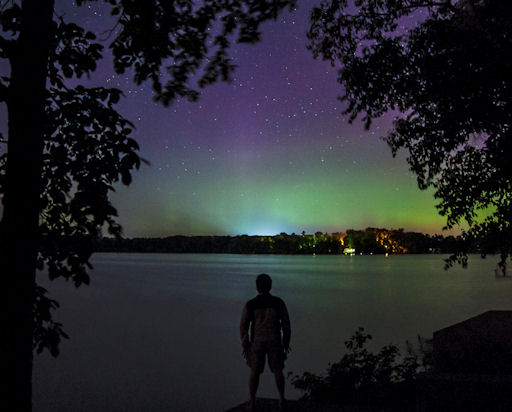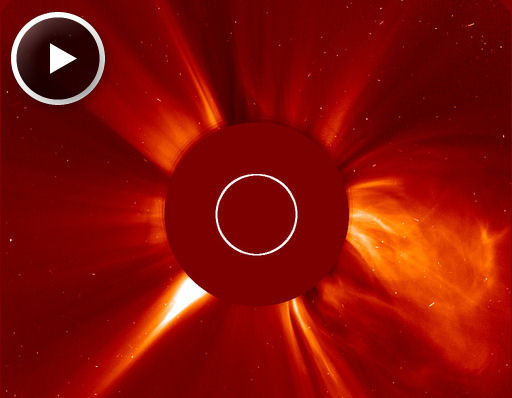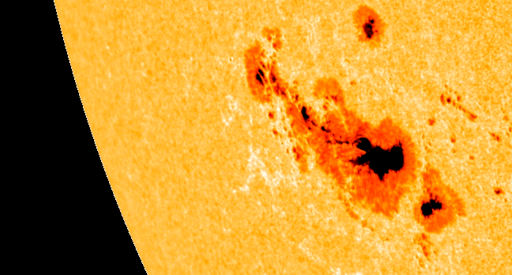They came from outer space--and you can have one! Genuine meteorites are now on sale in the Space Weather Store. | | |
MORNING SKY SHOW: Jupiter and Venus are converging in the morning sky for a beautiful conjunction that appears in the east just before sunrise. Check the realtime photo gallery for snapshots from around the world--and set your alarm for dawn.
AURORA SURPRISE: July 9th began with a brief but beautiful display of auroras over North America. "I had gone out to search for noctilucent clouds, but instead I found these Northern Lights," says Robert Snache of Rama First Nation, Ontario:

The source of the display was not an explosion on the sun, but rather a fluctuation in the interplanetary magnetic field (IMF). The IMF near Earth tipped south, briefly opening a crack in our planet's magnetosphere. Solar wind poured in and ignited the lights.
More auroras could be in the offing. A CME that left the sun on July 6th might deliver a glancing blow to Earth's magnetic field on July 9-10. NOAA forecasters estimate a 25% to 30% chance of polar geomagnetic storms if and when the cloud arrives. Aurora alerts: text, voice.
Realtime Aurora Photo Gallery
MANY CMEs: During the late hours of July 8th, a series of rapid-fire explosions on the sun propelled three coronal mass ejections (CMEs) into space. The Solar and Heliospheric Observatory recorded their exit:

Despite the number of eruptions and the breadth of the billowing ejecta, Earth is little affected. All of the clouds appear set to miss our planet. Nevertheless, this flurry of CMEs highlights the currently-high level of solar activity. It is only a matter of time before a significant CME comes our way. Stay tuned for stormy space weather.
Realtime Space Weather Photo Gallery
ANOTHER BIG SUNSPOT: As one big sunspot (AR1515) turns away from Earth, another one is turning toward our planet. AR1520, now emerging over the sun's southeastern limb, stretches more than 127,000 km (10 Earth diameters) from end to end:

AR1520 has a 'beta-gamma' magnetic field that harbors energy for M-class solar flares. So far, however, the sunspot's magnetic canopy is crackling with lesser C-flares. The calm before the storm? NOAA forecasters estimate an 80% chance of M-flares during the next 24 hours. X-flare alerts: text, voice.
Realtime Noctilucent Cloud Photo Gallery
[previous years: 2003, 2004, 2005, 2006, 2007, 2008, 2009, 2011]
Potentially Hazardous Asteroids (
PHAs) are space rocks larger than approximately 100m that can come closer to Earth than 0.05 AU. None of the known PHAs is on a collision course with our planet, although astronomers are finding
new ones all the time.
On July 9, 2012 there were potentially hazardous asteroids.
Recent & Upcoming Earth-asteroid encounters: | Asteroid | Date(UT) | Miss Distance | Mag. | Size |
| 2003 KU2 | Jul 15 | 40.2 LD | -- | 1.3 km |
| 2004 EW9 | Jul 16 | 46.8 LD | -- | 2.1 km |
| 2002 AM31 | Jul 22 | 13.7 LD | -- | 1.0 km |
| 37655 Illapa | Aug 12 | 37 LD | -- | 1.2 km |
| 2000 ET70 | Aug 21 | 58.5 LD | -- | 1.1 km |
| 1998 TU3 | Aug 25 | 49.2 LD | -- | 4.9 km |
| 2009 AV | Aug 26 | 62.8 LD | -- | 1.1 km |
| 1998 UO1 | Oct 4 | 60.1 LD | -- | 2.1 km |
Notes: LD means "Lunar Distance." 1 LD = 384,401 km, the distance between Earth and the Moon. 1 LD also equals 0.00256 AU. MAG is the visual magnitude of the asteroid on the date of closest approach. | | The official U.S. government space weather bureau |
| | The first place to look for information about sundogs, pillars, rainbows and related phenomena. |
| | Researchers call it a "Hubble for the sun." SDO is the most advanced solar observatory ever. |
| | 3D views of the sun from NASA's Solar and Terrestrial Relations Observatory |
| | Realtime and archival images of the Sun from SOHO. |
| | from the NOAA Space Environment Center |
| | the underlying science of space weather |

